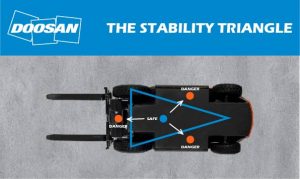As a piece of essential warehouse equipment, forklifts are everywhere. There are currently around 1,000,000 forklifts helping businesses stay organized, and productive throughout the United States. They are one of the most powerful tools in improving efficiency. However, with great power comes great responsibility. Forklifts can be hazardous, and the cause of expensive citations, workplace accidents, injuries, and even death.
According to the Occupational Safety and Health Administration (OSHA), forklift violations are consistently one of the top 10 violations costing businesses about $135,000,000 every year. OSHA also estimates that forklifts cause of approximately 110,000 accidents annually. Of these, about 35,000 resulted in serious injuries, and about 85 accidents resulted in death.
Any workplace that uses forklifts should emphasize forklift safety. Promoting forklift safety will prevent costly violations and accidents. Here are 5 ways to optimize forklift safety:
1. Make sure all employees are educated and properly trained and certified
Studies show that proper training and education is a great deterrent of accidents. Employers should develop and implement a training program based on the general principles of safe operation, the types of forklifts used in the workplace, the potential hazards in the workplace, and the general safety requirements of the OSHA standard. According to OSHA, with these training policies, about 70% of forklift accidents could be prevented.
Additionally, operators must be properly certified per OSHA regulations. OSHA requires forklift operator to be certified in a two-phase training course: a classroom-style training and test, and a hands-on evaluation. Only trained and competent operators can be permitted to operate a forklift. You can find all the necessary information about training and certification here.
2. Understanding your forklift’s load capacity and the Stability Triangle
Many forklift accidents happen because the operators are not knowledgeable about how much their forklifts can carry. In fact, tip-overs due overloading is a leading cause of forklift accidents. So, understanding your forklift’s load capacity is extremely important.
A forklift’s load capacity is found in two places: on the data plate of the forklift, and in the operator’s manual. This capacity refers to a balanced load carried on the stated load center. It can change depending on the attachments used, the height of the lift, and the length of the load.
-
- Forklift attachments are anything that is attached to the front carriage or attached to an attachment on the forklift. Generally, as you add attachments to the forklift, the load capacity decreases.
- Lift height also affects load capacity. Forklifts with high masts will have lower capacity as the lift height increases.
- The length of the load changes load capacity as well. The longer the length of the load is the lower the capacity.

Understanding the stability triangle helps with load capacity management, which is essential for forklift safety.
The above three points factor into the center of gravity of your forklift as well. To prevent accidents, a forklift’s center of gravity should be within what is known as The Stability Triangle. The Stability Triangle is a triangle formed by connecting the two front wheels and the pivot point of the rear axle.
With a load, the center of gravity of the forklift is at the center of the triangle. But as you add more weight to the forks or raise the mast with a load, the center of gravity shifts to the front of the triangle. Moving the center of gravity out of the Stability Triangle by adding too much weight or adding weight in the wrong places can cause tip-overs.
3. Perform daily inspections and regular maintenance
Maintaining your forklift is not just a great way to extend the life of your forklift, it is also one of the best ways to ensure forklift safety. Regular maintenance safeguards your forklifts against problems that go beyond the normal wear and tear. OSHA requires daily inspections to be performed at the beginning of each shift. If a forklift is equipped with a safety device, the device must be in good working order otherwise the forklift should be tagged out of service until it can be repaired. These daily inspections also help operators identify operational issues so they can be addressed before they become bigger problems or lead to accidents. By keeping your forklift in optimal working condition, you will have a safe operating experience.
4. Be aware of your work environment
A lack of awareness in the workplace can be detrimental not only to the products you are moving but also to your employees. Many accidents occur because the operator or someone in the forklift’s vicinity is not paying attention. Practice mindfulness by paying attention, keeping an eye on where you’re going, using your alarms to alert others of your presence, ensuring your loads are balanced and within load capacity, and driving safely. These five simple actions can prevent accidents and save lives.
5. Store your forklifts properly
Another way to promote forklift safety and prevent accidents is to store your forklifts properly after use. They should be parked on a flat surface. Engage your parking brakes. Make sure your forks are flush to the ground. The forklift should be turned off, and the keys should be removed from the ignition.
At DIVAC, safety is a top priority. Our facilities have strict safety protocols, and all our operators are certified. We practice what we preach! Additionally, we are proud to provide customers with warehouse vehicles that have more standard safety features. Features such as our exclusive Guardian Stability System and Operator Sensing System, our high visibility cab and our rear grab bar with horn button help operators stay safe while improving productivity. Many of our equipment can also be equipped with blue lights for added visibility to pedestrian traffic. For more information on our safe and ergonomic products, please contact us.


